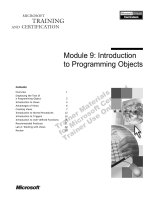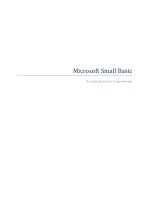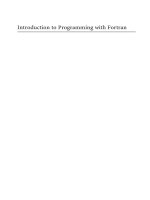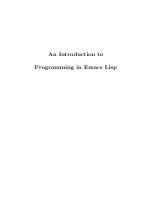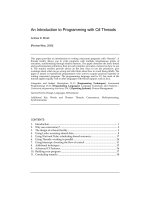Session 06 Introduction to Programming
Bạn đang xem bản rút gọn của tài liệu. Xem và tải ngay bản đầy đủ của tài liệu tại đây (171.56 KB, 18 trang )
LBC, Session 6
Array
FPT APTECH COMPUTER EDUCATION HANOI
Objectives
• Explain array elements and indices
• Define an array
• Explain array handling in C
• Explain how an array is initialized
• Explain string / character arrays
• Explain two dimensional arrays
• Explain initialization of two dimensional arrays
LBC/Session 6
2
What is Array?
• An array is a collection of data elements of the same
type.
• Each element of the array has the same data type,
same storage class and same characteristics.
• These elements are known as members of the array.
LBC/Session 6
3
Array Elements & Indices
• Each member of an array is identified by unique index or
subscript assigned to it
• An index is a positive integer enclosed in [ ] placed
immediately after the array name
• An index holds integer values starting with zero
• An array with 11 elements will look like:
players[0], players[1], …, players[10]
LBC/Session 6
4
Defining an Array-1
.
• An array has some particular characteristics and has
to be defined with them
• These characteristics include:
– Storage Class
– Data Types of the elements in the Array
– Array Name
Which indicates the location of the first
member of the array
– Array Size
a constant evaluating to a +ve value
LBC/Session 6
5
Defining an Array-2
• An array is defined in the same way as a variable is defined.
• The only change is that the array name is followed by one or
more expressions, enclosed within square brackets [],
specifying the array dimension.
storage_class data_type array_name[size]
Example:
int player[11];
LBC/Session 6
6
Norms with Arrays
•
All elements of an array are of the same type
•
Each element of an array can be used wherever a
variable is allowed or required
•
Each element of an array can be referenced using a
variable or an integer expression
•
Arrays
can
have
their
data
types
like:
int, char, float or double
LBC/Session 6
7
Array Handling in C-1
• An array is treated differently from a variable in C
• Two arrays, even if they are of the same type and size
cannot be tested for equality
• It is not possible to assign one array directly to another
• Values cannot be assigned to an array on the whole,
instead values are assigned to the elements of the array
LBC/Session 6
8
Array Handling in C-2
void main()
{
int ary[10];
int i, total, high;
for(i=0; i<10; i++)
{
scanf(“%d”,&ary[i]);
}
/* Displays highest of the entered values */
high = ary[0];
for(i=1; i<10; i++)
{
if(ary[i] > high)
high = ary[i];
}
printf(“\nHighest value entered was %d”, high);
}
LBC/Session 6
9
Array Initialization
• Each element of an automatic array needs to be initialized
separately
• In the following example the array elements have been
assigned valued using the for loop
char alpha[26];
int i, j;
for(i=65,j=0; i<91; i++,j++)
{
alpha[j] = i;
printf(“The character is %c \n”, alpha[j]);
}
• In case of extern and static arrays, the elements are
automatically initialized to zero
LBC/Session 6
10
Two-Dimensional Arrays
• The simplest and the most commonly used multidimensional array is the two - dimensional array
• A two-dimensional array can be thought of as an array
of two single dimensional arrays
• A two-dimensional array looks like a railway time-table
consisting of rows and columns
• A two–dimensional array is declared as -
int temp[4][3];
LBC/Session 6
11
Init of Multidimensional Arrays-1
int ary[3][4] =
{1,2,3,4,5,6,7,8,9,10,11,12};
The result of the above assignment will be as
follows :
LBC/Session 6
12
Init of Multidimensional Arrays-2
int ary[3][4]=
{
{1,2,3},
{4,5,6},
{7,8,3}
};
LBC/Session 6
13
Init of Multidimensional Arrays-3
The result of the assignment will be as follows :
A two - dimensional string array is declared in the
following manner :
char str_ary[25][80];
LBC/Session 6
14
Init array of string
void main ()
{
int i, n = 0; int item;
char lines[10][12];char temp[12];
printf(“Enter each string on a separate line”);
printf(“Type ‘END’ when over”);
do
{
printf(“String %d : ”, n+1);
scanf(“%s”, lines[n]);
} while (strcmp(lines[n++], “END”));
//to continue
LBC/Session 6
15
reorder the list of strings
/*reorder the list of strings */
n = n – 1;
for(item=0; item
/* find lowest of remaining strings */
for(i=item+1; i
if(strcmp (lines[item], x[i]) > 0)
{
/*interchange two stings */
strcpy (temp, lines[item]);
strcpy (lines[item], x[i]);
strcpy (lines[i], temp);
}
}
}
LBC/Session 6
16
Display the arranged list of strings
/* Display the arranged list of strings */
printf(“Recorded list of strings : \n”);
for(i = 0; i < n ; ++i)
{
printf("\nString %d is %s", i+1, lines[i]);
}
}
LBC/Session 6
17
Summary
• Define an array, element, index
• Array handling in C
• Initialization array
• Explain string / character arrays
• Explain two dimensional arrays
• Explain initialization of two dimensional arrays
LBC/Session 6
18
